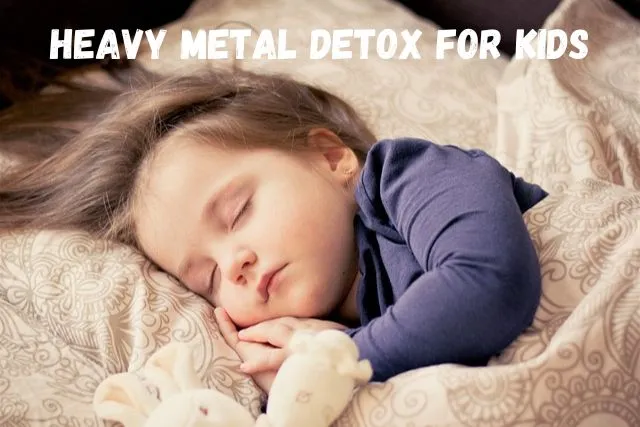Disclaimer: This article is for informational purposes only and should not be taken as medical advice. Always consult a qualified pediatrician or healthcare professional before starting any detox program or supplement for children.
Introduction
Parents today are increasingly concerned about toxins in their children’s bodies, particularly heavy metals such as lead, mercury, cadmium, and arsenic. Even small amounts of these metals can negatively impact a child’s growth, development, and overall well-being. This has led many families to explore heavy metal detox for kids—a process aimed at safely reducing toxic metals in the body through diet, lifestyle changes, and in some cases, medical supervision.
In this guide, we’ll explore what heavy metal detox for kids is, its causes, symptoms, possible natural remedies, and how parents can support their children’s health while ensuring safety.
What is Heavy Metal Detox for Kids?

Heavy metal detox for kids refers to methods that help reduce or eliminate toxic metals from the body. These metals can accumulate from various sources—contaminated food and water, pollution, household products, and even certain medications. Over time, they may contribute to health challenges such as learning difficulties, behavioral changes, digestive issues, or weakened immunity.
The detox process can include:
- Dietary changes – Incorporating foods that naturally support detoxification (like leafy greens, cilantro, and antioxidant-rich fruits).
- Supplements – Under medical supervision, some children may be given natural chelating agents such as chlorella or zeolite.
- Lifestyle adjustments – Reducing exposure to plastics, processed foods, and pollutants.
Common Sources of Heavy Metals in Kids

Children can be exposed to heavy metals in several ways, including:
- Food and water contamination – Rice, seafood, or water stored in old pipes may contain lead or arsenic.
- Air pollution – Living near industrial sites or high-traffic areas increases risk.
- Household products – Old toys, paints, and cosmetics may contain lead or cadmium.
- Passive smoking and medications – Certain unregulated drugs or smoke exposure can introduce toxins.
For more details, the EPA provides guidelines on drinking water safety.
Symptoms of Heavy Metal Toxicity in Kids

Heavy metal buildup often presents as vague symptoms, making it difficult to diagnose without medical tests. Some possible signs include:
Physical Symptoms
- Abdominal pain and nausea
- Frequent headaches
- Fatigue and muscle weakness
- Skin rashes or eczema
- Dark circles under the eyes
- Poor appetite or digestive issues
- Hair fall or brittle nails
Neurological & Behavioral Symptoms
- Difficulty concentrating
- Irritability or mood swings
- Hyperactivity (linked to ADHD-like symptoms)
- Memory or learning difficulties
- Anxiety and depression tendencies
According to the CDC’s Lead Poisoning Prevention Program, children exposed to high levels of lead and other heavy metals are at greater risk of developmental delays and learning issues. If your child is showing these symptoms consistently, consult a pediatrician for proper screening.
Read also: PBX Detox for Kids – A Comprehensive Guide
Heavy Metal Exposure and Neurodevelopment (ADHD)
Modern research continues to investigate the link between environmental toxins and neurodevelopmental conditions like ADHD (Attention Deficit Hyperactivity Disorder). While heavy metals are not the “cause” of ADHD—which is a complex, multi-factorial condition—they may act as a significant environmental stressor that can exacerbate symptoms.
-
Lead & Inattention: Low-level lead exposure has been consistently linked in studies to decreased IQ and shortened attention spans.
-
Mercury & Hyperactivity: High levels of mercury can impact the central nervous system, potentially leading to irritability and restlessness.
The Holistic Approach: Reducing the “toxic burden” on a child’s developing brain may improve the efficacy of other treatments, such as behavioral therapy or medication. Rather than viewing detox as a “cure,” experts suggest viewing it as removing a barrier to development, allowing the child’s nervous system to function more efficiently.
Natural Detox Support & Supplements
While a nutrient-dense diet is the foundation of health, some parents consider supplements to assist the body’s natural clearance of toxins. However, extra caution is required, as the supplement industry is not strictly regulated, and low-quality products can sometimes contain the very contaminants you are trying to avoid.
1. Essential Nutrients
Before turning to specialized detox agents, ensure your child has adequate levels of minerals that compete with heavy metals for absorption:
-
Iron and Calcium: Adequate levels can help prevent the body from absorbing lead.
-
Vitamin C: Acts as a potent antioxidant that may help protect cells from oxidative stress caused by metals.
2. Natural Binding Agents (Use Only with Professional Guidance)
These substances are often used in holistic protocols to help “bind” toxins in the digestive tract so they can be excreted rather than reabsorbed.
-
Chlorella and Spirulina: These nutrient-dense algae contain chlorophyll. It is vital to choose “broken cell wall” chlorella that is third-party tested for purity.
-
Zeolite (Clinoptilolite): A mineral with a cage-like structure used to trap toxins. Parents should only use liquid or powdered zeolites specifically processed for human consumption.
-
Probiotics: Strains like Lactobacillus have shown promise in studies for their ability to bind certain heavy metals in the gut.
⚠️ Safety Note: Never start a supplement protocol during acute heavy metal poisoning without a doctor’s supervision. If a child’s blood-lead levels are dangerously high, hospital-based medical chelation therapy is the only recognized treatment.
Comparison Table: Foods That Support Detox vs. Foods to Avoid
| Foods That Support Detox | Why They Help | Foods to Avoid | Why They Harm |
|---|---|---|---|
| Apples, blueberries, pears | Rich in antioxidants and fiber | Processed snacks, chips | High in additives and chemicals |
| Spinach, kale, broccoli | Contain chlorophyll to bind toxins | Fast food | High in unhealthy fats and sodium |
| Garlic and onions | Sulfur compounds support liver detox | Sugary drinks | Increase toxin load and weaken immunity |
| Oats, beans, flaxseeds | Fiber helps eliminate toxins | Packaged cereals (with additives) | May contain heavy metals and preservatives |
| Fresh water (filtered) | Flushes toxins naturally | Soda and energy drinks | Contains artificial colors and excess sugar |
Prevention: Reducing Heavy Metal Exposure
Prevention is always better than a cure. Parents can:
- Choose organic foods when possible.
- Use stainless steel or glass containers instead of plastic.
- Test water sources for lead contamination.
- Ensure children wash their hands regularly, especially before meals.
The WHO notes that there is no safe level of lead exposure, which makes prevention critical.
What Experts Say
The U.S. Food and Drug Administration (FDA) has proposed safety limits for heavy metals in baby food, such as 10 parts per billion (ppb) of lead in infant cereal and 20 ppb in other baby products. Similarly, pediatric health experts emphasize that reducing exposure early helps prevent long-term complications.
Read also: The Magic of Pure Body Detox for Kids
Conclusion
Heavy metal detox for kids is not just a trend—it’s an important health consideration for families concerned about long-term well-being. While symptoms like irritability, fatigue, or learning difficulties may sometimes be linked to heavy metal exposure, only professional testing and medical advice can confirm toxicity levels.
Natural remedies such as diet improvements, hydration, and supervised supplements can support detoxification, but prevention remains the best strategy. By reducing exposure to heavy metals in daily life, parents can safeguard their children’s growth and development.
Always remember: consult your pediatrician before starting any detox program. With professional guidance, heavy metal detox can become a safe and effective step toward ensuring better health and happiness for kids.
FAQs
1. Is heavy metal detox safe for kids?
Yes, if done under the supervision of a pediatrician or certified health professional.
2. What foods help with heavy metal detox?
Leafy greens, apples, blueberries, garlic, onions, and fiber-rich foods are supportive.
3. Does heavy metal detox cure ADHD?
No, it is not a cure. However, reducing exposure to toxins may help improve some symptoms when combined with therapy.
4. Can I use supplements for detox without consulting a doctor?
No, supplements like chlorella or zeolite should only be given under medical supervision.
5. How can I prevent heavy metal exposure in my child?
Use clean water, avoid processed foods, choose safe household products, and limit pollution exposure.
Read also: Zeolite Detox for Kids: A Natural Path to Cleaner Bodies
